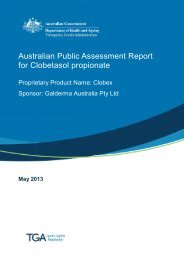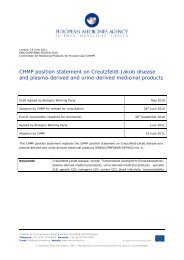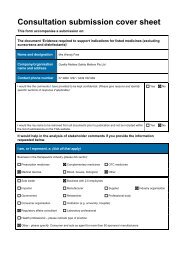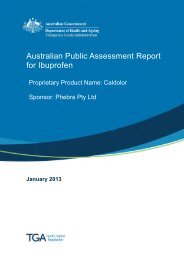AusPAR: Ivabradine - Therapeutic Goods Administration
AusPAR: Ivabradine - Therapeutic Goods Administration
AusPAR: Ivabradine - Therapeutic Goods Administration
You also want an ePaper? Increase the reach of your titles
YUMPU automatically turns print PDFs into web optimized ePapers that Google loves.
<strong>AusPAR</strong> Coralan <strong>Ivabradine</strong> Servier Laboratories (Australia) Pty Ltd PM-2010-03269-3-3<br />
Final 31 October 2012<br />
<strong>Therapeutic</strong> <strong>Goods</strong> <strong>Administration</strong><br />
revascularisation (percutaneous coronary intervention or coronary artery bypass graft),<br />
or had other significant cardiac or vascular conditions 6. Patients with moderate or severe<br />
liver disease (Child-Pugh score > 7), severe renal disease (serum creatinine > 220 μmol/L)<br />
or anaemia (blood haemoglobin < 110 g/L) were also excluded. Women who were<br />
pregnant or breast feeding and women of childbearing potential who were not on estroprogestative,<br />
progestative or intra-uterine contraception were also excluded.<br />
Comment: The inclusion and exclusion criteria aimed to recruit a study population of<br />
adult patients with chronic heart failure with NYHA Class II to IV, on stable and optimal<br />
CHF medications and reduced LVEF. The selection of patients with stable background<br />
treatment medications is consistent with the TGA adopted EU guidelines on the clinical<br />
investigation of drugs for treatment of cardiac failure 7. In addition, patients needed to<br />
be in documented sinus rhythm with a resting heart rate of ≥ 70 bpm. It is unclear what<br />
rationale the criterion of a resting heart rate of ≥ 70 bpm was based on. A literature<br />
search conducted by the evaluator shows that while clinical studies generally<br />
supported the relationship between a higher heart rate and higher mortality or<br />
morbidity in CHF patients, there is no definitive conclusion on what level of heart rate<br />
constitutes increased risk. One of the currently approved indications for ivabradine is<br />
the use in patients with chronic stable angina in “combination with atenolol 50mg once<br />
daily when heart rate is >60 bpm and angina is inadequately controlled” 8 .<br />
Study treatments<br />
The study drug was oral ivabradine or placebo to be taken twice daily (b.d). During the<br />
run-in period, no study treatment was dispensed. During the randomised double blind<br />
treatment period, the starting dose of study treatment (ivabradine or placebo) for all<br />
patients was 5 mg b.d at 12 hour intervals during meals. At 2 weeks (D014 visit), the dose<br />
was either maintained, up-titrated to the target dose of 7.5 mg b.d or down-titrated to 2.5<br />
mg b.d depending on resting HR on ECG and on tolerability. An upward adjustment to 7.5<br />
mg b.d was recommended if the resting HR was > 60 bpm or downward to 2.5 mg b.d if it<br />
was < 50 bpm or the patient was experiencing signs or symptoms relating to bradycardia.<br />
Patients with HR between 50 and 60 bpm inclusive were maintained on the 5 mg dose.<br />
At the D028 visit and at subsequent follow-up visits or at any time between 2 scheduled<br />
visits, the study investigators could maintain the study drug dose (for patients taking 2.5<br />
mg or 5 mg or 7.5 mg ivabradine or matching placebo) if the ECG resting HR was ≥ 50<br />
bpm; adjust the dose to the next upper dose (for patients taking 2.5 mg or 5 mg ivabradine<br />
or matching placebo) if the ECG resting HR was > 60 bpm; adjust the dose to the next<br />
lower dose (for patients taking 5 mg or 7.5 mg ivabradine or matching placebo) if ECG<br />
resting HR was < 50 bpm or the patient was experiencing signs or symptoms relating to<br />
6 These were, history of stroke or cerebral transient ischaemic attack within the previous 4 weeks; severe<br />
aortic or mitral stenosis, or severe aortic regurgitation, or severe primary mitral regurgitation;<br />
scheduled surgery for valvular heart disease; active myocarditis; congenital heart diseases; previous<br />
cardiac transplantation or on list for cardiac transplantation; cardiac resynchronisation therapy started<br />
within the previous 6 months; pacemaker with atrial or ventricular pacing (except bi-ventricular pacing)<br />
> 40% of the time, or with a stimulation threshold at the atrial or ventricular level ≥ 60 bpm; permanent<br />
atrial fibrillation or flutter; sick sinus syndrome, sinoatrial block, 2nd and 3rd degree atrio-ventricular<br />
block, history of symptomatic or sustained (≥ 30 sec) ventricular arrhythmia unless a cardioverter<br />
defibrillator was implanted; any cardioverter defibrillator shock experienced within the previous 6<br />
months; patients with familial history of or congenital long QT syndrome or treated with selected QT<br />
prolonging products; severe or uncontrolled hypertension (sitting systolic blood pressure > 180 mmHg<br />
or sitting diastolic blood pressure > 110 mmHg); sitting systolic blood pressure < 85 mmHg or current<br />
symptomatic hypotension.<br />
7 TGA adopted EU guideline: Notes for guidance on clinical investigation of medicinal products for<br />
treatment of cardiac failure. (CPMP/EWP/235/95 Rev 1).<br />
8 Australian Product Information, ivabradine.<br />
Page 10 of 101
















